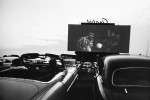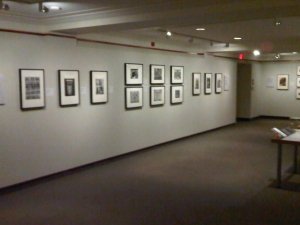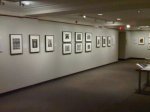As summer comes to a close, and we push through our annual August slow down, it’s no doubt our visitors are wondering what’s been going on at the DIA. Through African Eyes closed earlier in the month. The exhibition was carefully packed up and is now en route to the Nelson Atkins Museum in Kansas City, Missouri. A few select photographs from the DIA’s collection by West African photographer Sedyou Keita and South African artist Zwelethu Mthethwa will travel with other exquisite and very unique African treasures from museums around the world.
In the meantime, our special exhibitions galleries are presently in overhaul mode as we prepare for the November 21, 2010, opening of Fakes, Forgeries and Mysteries which will feature about 50 re-evaluated permanent collection works of all media and from many cultures. The exhibition explores the methods used by museums to examine and authenticate works of art. One photograph will be on view – a dubious Man Ray rayogram (also known as a photogram) that experts believe is a copy, but you’ll have to come to the exhibition to learn more about this.
With the Robert Frank photo exhibition closing in July, and our main photo gallery down for most of the year, behind the scenes preparations are ongoing for an upcoming season of new programs and more exhibitions in development. The Albert and Peggy de Salle Gallery is now under wraps for a fresh paint job and cleaning but will open again to the public on November 24, 2010, with An Intuitive Eye: André Kertész Photographs 1914-1969. Largely a permanent collection exhibition, we were fortunate to find the artist’s lesser known, but critical early Hungarian photographs which will be on loan from University of Michigan Museum of Art, Ann Arbor. From the DIA’s collection, we’ve included Kertész’s iconic work from Paris in the 1920s and 1930s in addition to late work he made throughout New York City after 1940. The exhibition is the first comprehensive survey of the artist’s work at the DIA and coincides with the 25th anniversary of his death in 1985.
Our stellar department support group – The Forum for Prints, Drawings and Photographs – will host a series of artist’s lectures this fall as well as an encore presentation by Philip Gefter on the work of André Kertész. Gefter traveled to Detroit and the DIA this past June for a talk on Robert Frank, and we so enjoyed it, we asked him back again! Join us for his lecture and a special preview of An Intuitive Eye at 7pm on Friday, November 19, 2010. The exhibition will open officially to the public on Sunday, November 24, 2010, and is free with museum admission.
On the publications front, DIA editor Judith Ruskin and I have finalized texts for an upcoming issue of the DIA’s Bulletin – the first dedicated solely to the medium of photography (the DIA’s Bulletin has been in publication since 1919). Ongoing research and interest in our growing collection by several colleagues across the nation led to the development of this journal. The issue will feature essays on permanent collection works including Victorian era photography as seen in the cyanotypes of Anna Atkins and examine the pre World War II era of pictorialism in the work of Paul Anderson. Also highlighted are contemporary photographs including work by Lewis Baltz, Hiroshi Sugimoto and Greg Crewdson and the young women of the so-called Yale School who rose to fame in the late 1990s. MFA, Boston, colleague Karen Haas was even kind enough to take time away from her research as curator of The Lane Collection to pen a very interesting article on a series of 1955 photographs made by Robert Frank for an essay on train travel for Fortune magazine. The Bulletin is due out sometime in September 2010 and will be available in our museum shop.
 One highlight from the summer was an email from writer and film producer Mary Dejarlais asking if I would take part in the upcoming documentary film based on the life and photographic work of Detroit native Bill Rauhauser, who recently celebrated his 92nd birthday. As a former photo student of Bill’s at the College for Creative Studies, Detroit, back in the 1980s, it was an absolute pleasure to share what I remembered about him as a mentor and creative spirit. And so few people know about his efforts to establish the DIA’s photography collection early in the 1960s. Bill still supports the DIA and attends events and exhibitions. News about the film’s première and accompanying biography will get posted here as soon as I get word from the producers, but we may see it screen locally in September 2010. Desjarlais is also the author of a biography about Bill to be published this fall.
One highlight from the summer was an email from writer and film producer Mary Dejarlais asking if I would take part in the upcoming documentary film based on the life and photographic work of Detroit native Bill Rauhauser, who recently celebrated his 92nd birthday. As a former photo student of Bill’s at the College for Creative Studies, Detroit, back in the 1980s, it was an absolute pleasure to share what I remembered about him as a mentor and creative spirit. And so few people know about his efforts to establish the DIA’s photography collection early in the 1960s. Bill still supports the DIA and attends events and exhibitions. News about the film’s première and accompanying biography will get posted here as soon as I get word from the producers, but we may see it screen locally in September 2010. Desjarlais is also the author of a biography about Bill to be published this fall.





































